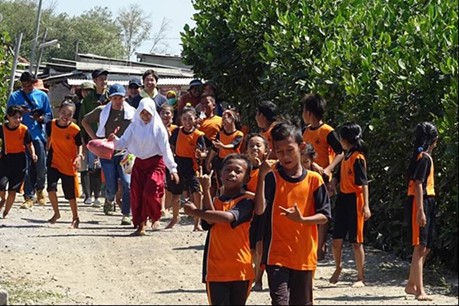Supporting for Bedono : Sinking village in Central Java

Background
Desa Bedono,Kec,Sayung,Kab,Demak Jawa Tengah Indonesia
Indonesia’s Dumac Province, home to Bedono Village, had a coast rich in nature covered with mangroves and was a thriving town for inland fishing. In particular, shrimp and crab caught abundantly, and it was a relatively rich fishing village compared to other nearby districts.

Source : Google Maps
In the late 1970s, the shrimp farming industry began, partly due to government policies. As a highly profitable industry, it accelerated rapidly in the 1980s, but the inability of farmed shrimps to cope with epidemic diseases and the decline in profitability resulted in many unso used farms being left untouched around1985.
In addition, when creating a farm, coastal mangroves were cut down, and waves from the sea relentlessly flooded the village, causing the coast to be eroded by seawater. The area was zero meters above sea level, with the collapse of the farm eroding morethan 2km of coast in justseven to eight years, and flooding 90% of Bedono village at high tide.
Business Overview
The Konica Minolta Labor Union has decided to provide support projects to Bedono Village as part of its social policy activities, and has been working with the cooperation of Oisca. The business overview so far is as follows.
Project for Regional Development Infrastructure development in Dumak Province, Central Java
Phase 1 (September2006 - August2009)
“Infrastructure development and educational support in fishing villages”
We mainly developed infrastructure, such as elementary school reconstruction activities (rebuilding school buildings, resanth landfills in submerged schoolyards, etc.), and tree planting activities. In addition, we also recruited members to participate, visited the site as volunteers, planted mangrove trees with elementary school children, and donated educational equipment and sports equipment. In addition, we actively interacted with villagers and children, such as homestays.
Phase 2 (April2010 - March2013)
“Infrastructure development and educational support in fishing villages”
In order to maintain the awareness of environmental conservation among residents who have s sprouted through the activities of the first phase, we carried out activities to raise awareness among residents and children who will be responsible for the next generation, such as afforestation, environmental education, and support for educational equipment (desks, chairs, blackboards, etc.). We also developed the necessary infrastructure, such as resanth landfills in submerged schoolyards.
Phase 3 (April2013 - March2016)
“Environmental Education and Education Support”
In order to continue the awareness of the environment of residents and children that have been fostered through their activities so far, and ultimately to gain the ability to protect, maintain, and develop the village themselves, we provided support through the “Children’s Forest*” plan promoted by Oisca. In addition to mangrove planting, we provided environmental education through school vegetable gardens, garbage disposal education, and eco-camps.
Greening activities
An effective way to protect villages from submerged crises is to green the village by planting mangrove trees. Mangroves planted along the coast prevent the soil from being exposed to waves and washed away. Mangroves planted offshore also prevent the occurrence of high waves by weakening tides and preventing strong winds, preventing coastal areas from wave erosion.
By promoting greening activities, the catch in the surrounding area increased due to the calming of the tide, and shellfish that had not been caught before were also caught. In addition, the increase in mangrove “dead trees” has resulted in many wild birds flying in, inging a good circulation in the ecosystem.
In addition, there is an economic effect of increasing catches and the birth of the tourism industry. One of the results of greening activities is a place called “Mangrove Forest” locally. This promenade is also built with government money, and it is a place crowded with tourists on weekends. There are still a few things to do, such as motorbike taxis, boat transfers, and food and beverage sales, but it is an income for villagers.
When they first started mangrove planting activities, many villagers seemed to be indifferent, but now, the interest of villagers is also increasing, such as voluntarily planting mangroves around their home. In addition, the base was steadily expanding, such as a group of university students participating in mangrove tree planting volunteers on holidays. We will continue to support greening activities.


Bedono Volunteer July 20 - 25, 2019
Since 2006, konica minolta labor union has been implementing support activities aimed at environmental education, treeplanting activities, and elementary school reconstruction activities as reconstruction support.
At present, reconstruction is gradually progressing, and local children are shifting to activities to cultivate “love for nature” and “feelings of cherishing greenery” through activities to plant and grow seedlings in schools and regions.
A total of eight members from Japan participated in volunteer activities for mangrove planting activities held in 2019.


*The Children’s Forest Project, sponsored by Oisca, will support local children’s tree planting and environmental education activities in schools and regions at 4,891 schools in 36 countries and regions around the world for 26 years. Children have been promoting activities for global greening while nurturing a “heart that loves nature” through activities such as planting and growing seedlings.